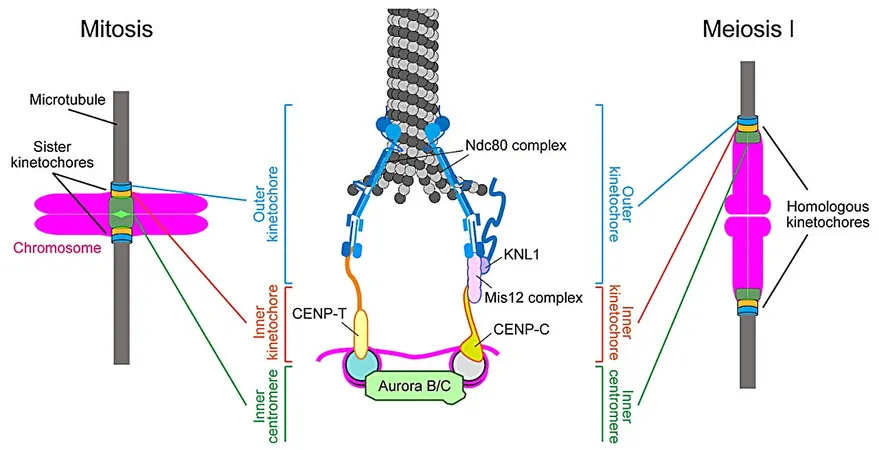
Revolutionary Synthetic Beads Could Transform Cell Division Insights and Disease Prevention
2025-01-09
Author: Jia
Introduction
In an exciting breakthrough, scientists at RIKEN have developed artificial structures that mimic the critical process of chromosome division in cells, a discovery that could vastly improve our understanding of cell division and its manipulation. This innovative study sheds light on one of nature's most pivotal processes—how cells accurately split their genetic material during division.
The Process of Cell Division
When a cell prepares to divide, it undergoes a meticulous alignment phase known as chromosome alignment, akin to a highly strategic tug-of-war game. In a functioning cell, chromosomes are tightly organized at the center with fibers extending from opposite sides. These fibers attach to kinetochores, which are necessary anchors that ensure chromosomes are divided equally, allowing each of the two new daughter cells to receive the correct set of genes.
Balanced tension during this process is crucial. If this tension is disrupted, it can lead to incorrect chromosome distribution, which may result in severe consequences, such as the onset of cancerous cells or genetic abnormalities.
The Role of Kinetochores
Kinetochores are complex structures composed of numerous proteins layered intricately—some interfacing with dividing fibers and others connected to the DNA. Remarkably, a team led by Tomoya Kitajima from the RIKEN Center for Biosystems Dynamics Research discovered that it’s possible to simplify kinetochores down to just two essential proteins while maintaining their pivotal role in chromosome alignment.
Development of Synthetic Kinetochores
These two proteins were affixed to tiny magnetic beads, resulting in synthetic, miniaturized kinetochores that operate efficiently as anchors for the dividing fibers.
When introduced into mouse cells, these artificial constructs functioned similarly to natural kinetochores, effectively joining the cellular tug-of-war while sustaining the vital tension for precise chromosome alignment. This pioneering demonstration could herald a new era in synthetic biology and open avenues for innovative disease prevention strategies. The research findings are documented in the prestigious journal Science.
Implications for Medicine
“Artificial kinetochores could revolutionize how we segregate DNA or other materials during cell division,” Kitajima notes. “This tool could lead to engineered cells with specific capabilities.”
Kitajima believes these designer kinetochores can serve as precision instruments to modulate biological processes reliant on balanced tension between chromosomes. The implications for medical applications are incredibly promising.
Specifically, this research paves the way for preventing or treating diseases linked to chromosome instability, a key factor in genetic disorders such as cancer and Down syndrome. In related research, the team demonstrated that their synthetic kinetochore beads could significantly reduce chromosome-sorting errors in aging mice’s egg cells.
Future Perspectives
“The initial effects on error reduction are promising yet limited,” states Kitajima. “However, enhancing the design of these artificial kinetochores could lead to more effective prevention of chromosomal errors.”
As scientists continue to explore the extensive potential of these synthetic structures, we stand on the brink of new breakthroughs that could reshape our approach to cell biology, genetics, and ultimately, disease treatment.
 Brasil (PT)
Brasil (PT)
 Canada (EN)
Canada (EN)
 Chile (ES)
Chile (ES)
 Česko (CS)
Česko (CS)
 대한민국 (KO)
대한민국 (KO)
 España (ES)
España (ES)
 France (FR)
France (FR)
 Hong Kong (EN)
Hong Kong (EN)
 Italia (IT)
Italia (IT)
 日本 (JA)
日本 (JA)
 Magyarország (HU)
Magyarország (HU)
 Norge (NO)
Norge (NO)
 Polska (PL)
Polska (PL)
 Schweiz (DE)
Schweiz (DE)
 Singapore (EN)
Singapore (EN)
 Sverige (SV)
Sverige (SV)
 Suomi (FI)
Suomi (FI)
 Türkiye (TR)
Türkiye (TR)
 الإمارات العربية المتحدة (AR)
الإمارات العربية المتحدة (AR)